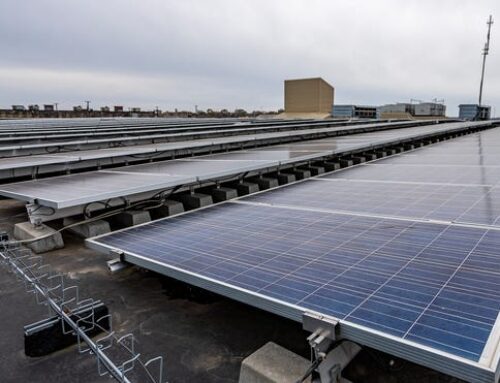Latest Dominion Energy Development Forecasts Raise Ire of Virginia Environmentalists
October 17, 2024
Dominion Energy, Virginia’s monopoly utility, did little to escape scrutiny from the state’s environmental community earlier this week when it released its integrated resource plan, a document that underscored the company’s commitment to natural gas infrastructure.
Environmental groups in Virginia have been hounding Dominion to use clean energy to meet forecasted demand growth, and eschew new fossil fuel infrastructure.
This year, Dominion was required by state law to conduct a “stakeholder process” as part of its integrated resource plan, which offers a rare glimpse into company leaders’ thinking, and gives customers a roadmap for how the utility plans to meet energy demand in the coming decades. These plans do not contain project proposals or rate changes.
Dominion’s 2024 plan highlighted its clean energy commitments while underscoring its commitment to pursuing new natural gas generation to meet forecasted spikes in energy demand. The plan “utterly fails to meet the moment” presented to the utility by climate change and the nation’s energy transition, said Peter Anderson, director of state energy policy with Appalachian Voices.
PJM, the region’s grid operator responsible for providing electricity to 13 states and the District of Columbia, has forecasted electricity demand to spike dramatically by 2039. To meet this soaring demand, Dominion outlined “an ‘all of the above’ approach” to its energy portfolio.
Keeping natural gas in its portfolio has been the root cause of several tense public meetings between Dominion and its customers. The company is evaluating sites for new natural gas power plants, including peaker plants, facilities that can generate energy quickly in response to spikes in demand. In its planning document, the company also explored the possibility of blending hydrogen into its fuel mix, an expensive and energy-intense process, to decrease emissions from gas-fired plants.
Dominion is also building “the largest offshore wind farm in the United States,” the company noted in its planning document, which projected additional increases in solar, transmission and energy storage capacity in the coming decades while retaining and possibly expanding nuclear energy capacity. “We remain committed to transitioning to a cleaner energy future, consistent with state and federal public policy directives, in a manner that does not compromise reliability or affordability,” Dominion wrote.
According to PJM, data centers, which enable many facets of modern life, including large language model artificial intelligence, are the driving force behind increasing energy demand. Virginia is known as the data center capital of the world, with Loudoun County home to the highest concentration of data centers on the planet.
Anderson said that the PJM load forecast, which predicts staggering amounts of new demand, is assembled with the help of utilities. “I am skeptical of the load forecast used here,” he said. Different utilities in the region could count the same proposed project as part of their load growth, he noted.
When forecasting its development in Virginia, Dominion considered five scenarios. In one of them, the company laid out generation and emissions predictions if a suite of new Environmental Protection Agency (EPA) regulations governing greenhouse gas emissions and air pollution were rolled back by the courts; in three others, the company operated under either state or federal environmental protection laws—or both—including Virginia’s Clean Economy Act, which requires Dominion to generate all its electricity from renewable energy by 2050 and beyond. It fed these assumptions through a model and found that meeting state and federal environmental laws resulted in the most drastic cut to the company’s emissions while yielding the lowest profit for Dominion.
In response to “stakeholder input” the company also forecasted one other scenario in Virginia: a world where it did not build any new natural gas infrastructure. The company is not expected to pursue this vision.
None of Dominion’s models included retiring fossil fuel assets, something mandated by the Virginia Clean Economy Act, which does allow for case by case exceptions to retirement for reliability. As a result, Virginians are not looking at a clear picture of how Dominon can combat climate change, said Rachel James, a staff attorney at the Southern Environmental Law Center (SELC).
“What does it mean to plan for clean energy when your utility refuses to show you what that could look like?” she said. “It’s a challenging starting point.”
In total, Dominion could add around 20,000 megawatts of clean energy (not including nuclear) and energy storage by 2039, and increase its natural gas generation by close to 6,000 megawatts. If EPA emissions and air quality regulations were rolled back in the coming decades and the Virginia Clean Economy Act was repealed, too, Dominion’s emissions could be as high as 25 million metric tons of carbon, an increase from its emissions earlier this decade, the company reported.
“I’m not surprised by anything I see because of the inherent capital bias in the regulatory system that we have,” said Anderson. By spending more money to build more infrastructure—regardless of emissions—Dominion can increase its profits, he said. “This is par for the course with Dominion.”
“No single energy source, grid solution or energy efficiency program will reliably serve the growing needs of our customers,” said Ed Baine, president of Dominion Energy Virginia, in a statement accompanying the IRP’s release. “Our comprehensive plan ensures we can always deliver reliable, affordable and increasingly clean energy—day or night, rain or shine, winter or summer.”
The SELC plans to intervene on behalf of Appalachian Voices in public comments before the State Corporation Commission, which will decide whether to approve or deny Dominion’s plans.
Anderson spoke on his way to a clean energy conference in Virginia, where he was scheduled to present about meeting rising electricity demand in the context of Virginia’s clean energy laws. “We’ve got the technology,” he said. “The question is, do we have the will.”
About This Story
Perhaps you noticed: This story, like all the news we publish, is free to read. That’s because Inside Climate News is a 501c3 nonprofit organization. We do not charge a subscription fee, lock our news behind a paywall, or clutter our website with ads. We make our news on climate and the environment freely available to you and anyone who wants it.
That’s not all. We also share our news for free with scores of other media organizations around the country. Many of them can’t afford to do environmental journalism of their own. We’ve built bureaus from coast to coast to report local stories, collaborate with local newsrooms and co-publish articles so that this vital work is shared as widely as possible.
Two of us launched ICN in 2007. Six years later we earned a Pulitzer Prize for National Reporting, and now we run the oldest and largest dedicated climate newsroom in the nation. We tell the story in all its complexity. We hold polluters accountable. We expose environmental injustice. We debunk misinformation. We scrutinize solutions and inspire action.
Donations from readers like you fund every aspect of what we do. If you don’t already, will you support our ongoing work, our reporting on the biggest crisis facing our planet, and help us reach even more readers in more places?
Please take a moment to make a tax-deductible donation. Every one of them makes a difference.
Thank you,
Search
RECENT PRESS RELEASES
Related Post





